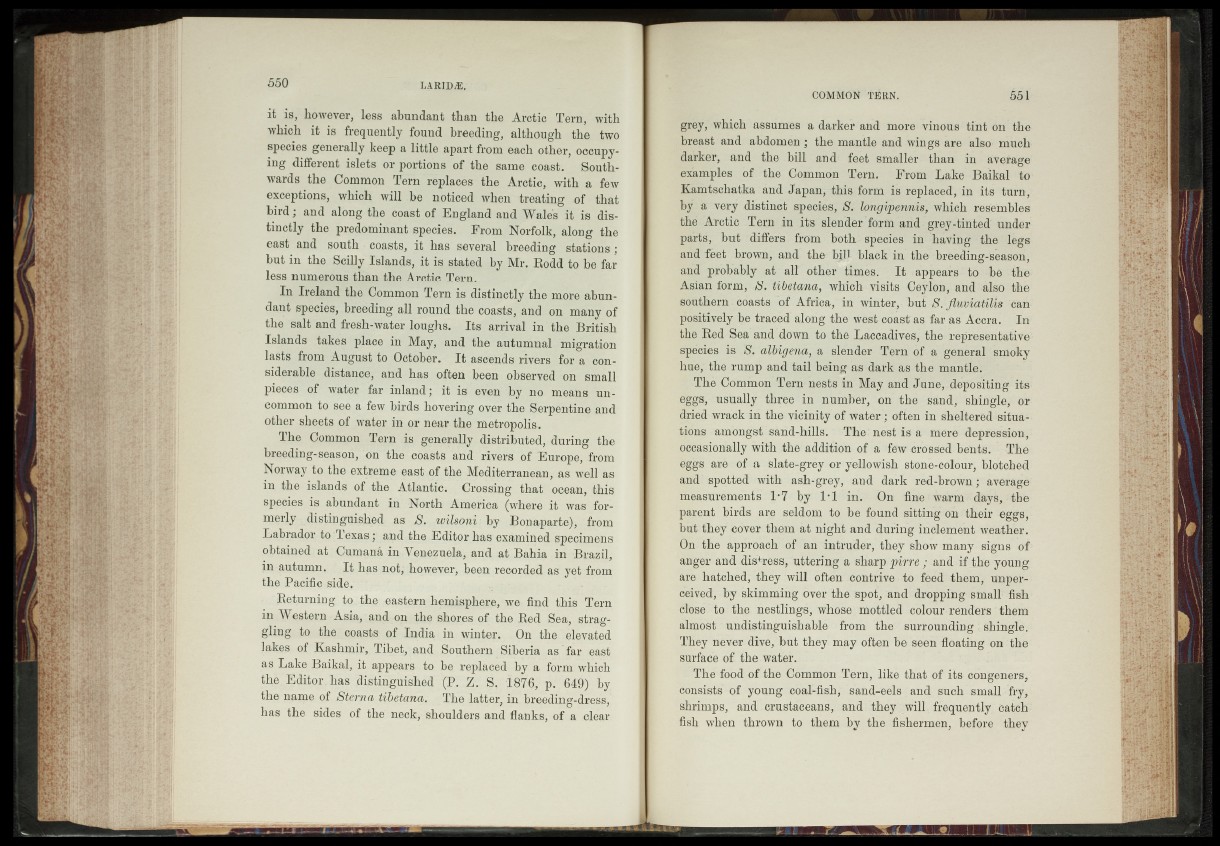
it ig, however, less abundant than the Arctic Tern, with
which it is frequently found breeding,, although the two
species generally keep a little apart from each other, occupying
different islets or portions of the same coast. Southwards
the Common Tern " replaces the Arctic, with a few
exceptions, which will be noticed when treating of that
bird j and along the coast of England and Wales it is distinctly
the predominant species. From Norfolk, along the
east and south • coasts, it has several breeding stations;
but in the Sciljy Islands, it |s stated by Mr. Rodd to'be far
less numerous than the Arctic Tern.,
In Ireland thé Common Tern is distinctly'the more abundant
species, breeding all round the coasts, and- on many of
the salt and fresh-iwater loughs. Its arrival in the British
Islands takes place invMay, and the autumnal migration
lasts from August to ÖctbBër. It ascends rivers for a- considerable
distance, and has often been observed -on small-
pieces of water far inland; it is even 'by'no means uncommon
to see a few birds hover|ng oyesr, the Serpentine and
other sheets of water,in ^>r near therm^trQpoljs. <■
The Common Tern i s generally distributed, during the
breeding-season, bn the coasts and rivers pf Europe, from
Norway to the extreme- east of the Mediterranean,- as well as
in the islands of the Atlantic^,' Crossing that ocean, this
species is, abundant in North America (where.it was ,for-
m®rly jdistingqighpdj as w i^ ^ hX ^ o n ap a rtp S ifrom
Labrador to "Texas; and the.Êditorhas examined specimens
obtained rat Cumana in Venezuela,-and at Bahia in Brazil,
in-autumn. It has not; however, been recorded as" yetifrom
the Pacific-side.' r’
' Returning^ tq..Ah§.^eastern hemisphere, ^ e find "this Tern
in Western Asia, and-on,,-the ^hp-res.ofi the^ed-^ea,-straggling
to the. epasts; of India in winter.! >jpnc th e ^ l^ t e d
lakes v of" Kashmir, Tibet, and Southern ‘.^Siberia jag far east
as^ Lake;Baikal, it appears to he yepfeegdchy-% form which
thé. Editor, has distinguished # 1876, p.’ ty
the name of .pi&rpia M h e t a n The latter, in, hreeding-dje^S,'
has the sidés of the neck, shoulders and flanks, of .a clear,
COMMON TERN. 551
grey, which assumes a darker and more vinous tint on the
breast and abdomen ; the mantle and wings are also* much
darker, and the bill andf feet smaller than in average
examples of the Common Tern. From Lake Baikal to*
Eafntschatka and Japan, this form is replaced, in its turn,
b / a jyery distinct species, S. longipennis, which resembles
the-Arctic Tern in .its slender‘form and "greyTtinted- under
parts, but differs from both - species’ in having the legs
and feet brown, and the bjjl black in-the breeding-season,
and probably -at all other- times. ' It appears' to -be the'
Asian form, &:' tibetana, which and also the'
southern: coasts of Africa, in winter, but /S'. flUmaiilis can-
positively be traced along the west coast as far as Accra. In
the Red Sea and down toj(thg Jliaccatdiyes^ the representative-
species slender Tern of a, general smoky
hue/, the rump and tail being as dark as the mantle.
^iThe Common" Tern- nests in May and Juh'e";'-depbslting if#
eggs, * usually three initiiumber, !on the sand, Shingle, or-
dried wrabk in the vicinity of Water"; often in sheltered-situations
amongst;sand-hills;' I The: nest is a mere depression^
-ecca'siohally with the addition, efila few crossed-bents. ’ -The -
eggs arei of a slateigreyl:©f yellowish stgne-eolbup, blotched
and spotted'with ash-grey, and dark red-brown,; average-
measurements ,1*7 by l ' l in.- "On fine' warm. days, -the-
parent birds ai;g seldom to be found sitting ?on'their eggs,’
but they coverAhem .-at night and during indement weather.
On. the approach ,of <an intruder,!they show many -sighs -of1
anger and distressT^uttering a sharp pirre ;~and iftb'e young.'
are hatched,"they-will often'Contrive-to feed them, unper-
oei$ed, - by skimming over the spot, and dropping sfnalL fish -
dose" to :fhe. nestlings, whijse; mottled colour renders them
almost undistinguishable from the"-'surrounding \ shingle.
They never dive, but they may often be-seen'floating on the :
Surface of the .water.? I
gpEhefood oCthe Common Tern, like that of its Congeners,
consists of young coal-fish,* sand-eels ’ and such, small- fry, i
shrimps, and. crusta'ceans, and. -they , will, frequently Catch
•fish when thrown to them.-, by the fishermen, before they